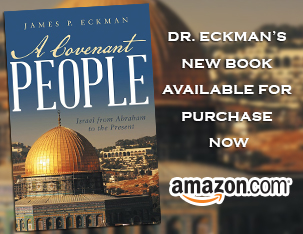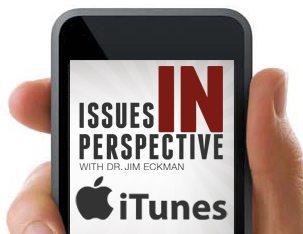The Embryo Question
May 17th, 2025 | By Dr. Jim Eckman | Category: Culture & Wordview, Featured IssuesThe mission of Issues in Perspective is to provide thoughtful, historical and biblically-centered perspectives on current ethical and cultural issues.

Anna Louie Sussman of the New York Times writes, “Scientists are doing human embryo research that could, for instance, help prevent miscarriages. Companies are pushing the boundaries of what kind of testing can be done on embryos in the name of optimizing future lives. Embryos are at the center of divorce cases that are part property dispute, part custody battle.
What kind of rules should govern this research? Should businesses that profit from embryos be subject to any kind of oversight? And how should the law speak of them? Wherever embryos appear, they bring with them serious ethical and intellectual questions about what meaning or place they hold in our society.
The political fights over abortion demand a great deal of attention. But embryos also demand and warrant a meaningful conversation about everything they represent: values, knowledge, family, religion, health, life, death and more. The boundaries of what we are doing with embryos are shifting quickly. Any attempt to shape the future of how we treat them has to engage with these questions now.”
Sussman’s observations introduced a profoundly important series of articles published in the New York Times in April 2025 on the embryo question. This series was organized around three “chapters” that highlight the vital center of this quite important debate occurring within America, indeed throughout the world. The series asks the right questions and highlights the central issues of this debate. In this Perspective, I want to summarize and then evaluate significant portions of this series of articles.
Should we limit embryo research?
For as long as scientists have worked with embryos, they have faced ethical questions about where to draw the line: How long is too long to grow a human embryo for research purposes? Two weeks? Four weeks? Or somewhere beyond? Does it matter if that research may one day help prevent miscarriages or serious fetal anomalies? For decades, scientists around the world have abided by one widely accepted rule: Embryos being grown for research may not be cultivated beyond the 14-day mark. Why 14 days?
- “That cutoff was based partly on biology—14 days is typically when an embryo develops a structure known as the primitive streak, a sign it will no longer turn into twins — and partly on a recognition of the power of simple guidelines.
- In fertility clinics, embryos (produced via in vitro fertilization [IVF]) typically grow in petri dishes for three to five days before being transferred into a patient’s uterus (or cryogenic storage); it was widely thought that an embryo required this transfer to continue developing. “Any gems that lie beyond the 14-day mark remain out of reach. And so, depending on your perspective, a rule that was once hypothetical has become either a restraint holding us back from understanding a critical stage of human life or a crucial check on the scientific impulse to push limits simply because we can.”
Is the 14-day standard subject to change? Sussman argues that “The rule may be poised to change. In 2021 the International Society for Stem Cell Research, a nonprofit scientific body that sets widely adopted global research norms, proposed that, contingent on ‘broad public support’ and legality in a given jurisdiction, ‘a specialized scientific and ethical oversight process could weigh’ whether researchers would be permitted to grow embryos beyond 14 days. The new guidelines call, first and foremost, for ‘public conversations touching on the scientific significance as well as the societal and ethical issues raised by allowing such research.’ In some countries, this conversation has already begun. The scientific significance of the research is clear. The period between the 14th day, when research must end, and the 28th day, when scientists can turn to embryonic tissue obtained from miscarriages or abortions to study, is when many pregnancies fail. It is also when organs begin forming and conditions such as cardiac abnormalities and neural tube defects arise. Observing that period of embryo development, often referred to as the black box of pregnancy, could lead to interventions for these developmental disorders and countless other medical breakthroughs. The societal and ethical issues, however, are also easy to grasp. Even people who do not equate embryos with human beings may be unsettled by the idea of growing them in dishes to increasingly advanced stages for research purposes.”
Sussman connects the 14-day standard with IVF: “Today a majority of I.V.F. cycles still end in failure, and approximately one-third of infertility cases are classified as unexplained. The push past 14 days is, in part, a bid to better understand what makes a pregnancy stick. But there are other important questions at play. As embryonic cells start to differentiate into the body’s major organs, how do stem cells become brain cells? How does the heart take shape? What determines the fate of cells that are chromosomally abnormal? ‘In my conscience, I know there are great benefits in pushing past 14 days,’ Dr. [Ali] Brivanlou [of Rockefeller University] has said. ‘It may literally save lives in the next generation.’ But the bioethicist Ben Hurlbut suspects others welcome the guardrails, worried about what they might otherwise conjure. He is troubled by the rapid leap from ‘can’ — the ability to culture embryos beyond 14 days — to ‘should,’ without much due paid to the basis for the rule. ‘Almost instantly, you have a kind of discourse of the need to revise the limit . . . Why? In what other domain of life would we say, when it becomes possible to violate a rule, that the rule has to give way to the violation?’ The 14-day rule has always been slightly arbitrary; a 21- or 28-day rule would be even more so. What, then, would be stopping us from going even further?”
Because of the growing debate about the 14-day standard, some ethicists and biologists “have proposed a new legal definition for ‘embryo’ that emphasizes its potential to become a fetus rather than whether it originated via fertilization or it was created in a lab from stem cells. With embryo models growing in sophistication, they argued in a commentary in the journal Cell, the relevant question is not how they got here but where they are going. A redefinition may offer some conceptual clarity, but it highlights the oddness of this moment — one in which our scientific prowess has pushed boundaries so far that we need to reconceive of entities whose previous technical definition seemed self-evident.”
What about the federal government and IVF and the 14-day rule? “It is too early to tell how President Trump will govern embryo research in his second term. But Mr. Trump is also surrounded by vocal natalists such as his donor and adviser Elon Musk, a prolific I.V.F. user, as well as Peter Thiel, who has invested in multiple fertility-related companies . . . In February the president signed an executive order that calls for policy recommendations to protect access to I.V.F. and lower its costs (‘because we want more babies,’ Mr. Trump said in an accompanying statement). The administration has a more limited ability to affect the 14-day rule, which in the United States isn’t a law but a guideline. Embryo research and research on fetal tissue are permitted on a state-by-state basis—New York, for example, has no limit on how long embryos may be grown for research purposes, whereas in California the guideline is 12 days—mirroring in some ways the current state of abortion access. The federal government has imposed restrictions through its funding, but much of the research on early human development relies on private funding from wealthy donors, foundations or venture capitalists.”
Are Embryos property? People?
In February 2024 the Alabama Supreme Court ruled that embryos were “extrauterine children,” No longer potentially destined for research or disposal, each embryo had taken on the status, in the court’s interpretation, of a minor child. The ruling swiftly established what had long eluded abortion opponents: unambiguous personhood for embryos. But this new legal status also instantly jeopardized in vitro fertilization practice across Alabama, sending clinics and patients scrambling amid confusion over what kind of liability clinics bore for the embryos — now legally children — in their care. As a dissenting justice noted, “No rational medical provider would continue to provide services” for creating and freezing embryos knowing that it might risk a wrongful death claim. Patients with scheduled embryo transfers had their appointments canceled as several clinics announced they were pausing operations. At least one major embryo shipping service said it would no longer make or take deliveries of embryos in the state.
Less than three weeks after the court ruling, Alabama’s legislature passed a law protecting I.V.F. providers from civil and criminal liability. Gov. Kay Ivey swiftly signed it, over opposition from anti-abortion groups, which argued it offered no accountability whatsoever for clinical mishaps. The law studiously avoided addressing any of the ethical questions raised by the court ruling and the furor that ensued. If I.V.F. was to be protected, did that mean embryos didn’t really have full personhood? Or if embryos did have full personhood, what kind of law would protect a business from liability in the event of it destroying an entity legally considered a child? The uncertain moral status of these clusters of cells burst into view, undermining any attempt to put them into a neat legal category.
Since then, confusion about how to answer these questions has generated yet more confusion. The overturning of Roe gave lawyers arguing for embryonic personhood a new legal avenue to pursue. In a recent Texas divorce case Caroline Antoun sought to use the Dobbs decision to help void a contract that would award the couple’s frozen embryos to her ex-husband, Gaby Antoun.
- “For years, it has largely been anti-abortion groups that intervened in cases involving embryos, using these private lawsuits as means to a public end: to help secure an embryo’s status as a full legal person, as the Harvard legal scholar I. Glenn Cohen pointed out to me. Yet when that goal was taken to its logical extreme, through the pronouncement of the Alabama Supreme Court, some in the little-known world of embryo adoption found themselves wincing at what felt like an own goal.”
- “The embryo adoption movement was born in the late 1990s when John and Marlene Strege, two observant Christians living in California, spoke with their fertility doctor about using anonymously donated embryos to get pregnant. They were intrigued but thought the process was due more respect than the mere signing over of some leftover tissue. (Transferring embryos from one party to another is not legally adoption and is typically treated as a simple transfer of property — not so different from handing over a car.) “These are lives, created at conception,” Mr. Strege later wrote. “You donate money, food, clothing, time, but you don’t donate life.” He and Ms. Strege, along with the agency Nightlight Christian Adoptions, developed a program that mimicked the regular adoption process by requiring similar screenings and home studies but relied on embryos’ status as property to keep legal costs low. Although the Streges have long insisted their embryo adoption activism is distinct from their anti-abortion views, in 2021 the Streges filed an amicus brief in the Dobbs case, which they illustrated with their daughter’s baby photos and a picture of her as an embryo.”
Sussman concludes that “The questions raised by these legal scenarios, some unfolding with increasing regularity, should spur us to grapple with the current inconsistencies in our laws and ethics. These questions are likely to become even more salient in the years ahead: Hundreds of thousands of people undergo I.V.F. every year in the United States; hundreds of thousands more get divorced. Procedures go awry. Clinics make mistakes. As a result of these ordinary events, people will continue to contest the meaning and fate of embryos in courts, where, as we have seen, there are few consistent guidelines.”
Ryan T. Anderson, president of the Ethics and Public Policy Center, argues caustically that “IVF itself treats children as products of technical manufacture. It thus fails to respect the equal dignity of human beings in their very origins. Or as some have put it, persons should be begotten, not made. They are to be welcomed as the fruit of an act of marital love. Relating to a child instead as a producer relates to a product is the seed of all the abuses of the IVF industry—the causal creation and destruction of “spares,” the filtering out of “defectives,” the selection for sex (boys) and other specs (eye color), the commodification of (often poor) women’s bodies as incubators.”
In conclusion, issues and practices associated with reproductive and genetic technologies fall under the stewardship responsibility of humanity to God. In Genesis 1:26ff, God created humans—male and female—in His image and then gave them the responsibility to “be fruitful and multiply, and fill the earth and subdue it; and rule over the fish of the sea and over the birds of the sky, and over every living thing that moves on the earth (1:28).” Verse 29 extends this dominion to plants, trees and seeds. God affirms this dominion status, although affected by human sin and rebellion, to Noah in Genesis 9:1-2. Because God is sovereign and humans have dominion status, human accountability is a necessary corollary. This matter of accountability has powerful implications when it comes to reproductive and genetic technologies. These technologies give humans power never realized before in history. But because of human depravity, it is difficult to be optimistic about the ultimate use of some of these technologies. In His common grace, God has permitted the human race to develop these technologies—but we must always remember that we are accountable to Him as to how we use them. The sobering fact of human depravity looms over its use. Therefore, let me posit several inferences:
- Freezing sperm and eggs does not jeopardize the life of a human being, because before fertilization there is no human being.
- However, embryo freezing is problematic if, as is most likely the case, in vitro fertilization (IVF) was used to produce the embryo in the first place. Normally, IVF involves multiple fertilizations and thereby multiple embryos, with those not implanted in the womb being destroyed or frozen. What happens to the remaining embryos that are not implanted or frozen is an ethical problem. Psalm 139:16 makes it quite clear that God values even embryonic life.
- Embryonic life must be protected. Since the embryo is a person in God’s eyes (see Psalm 139:16), the embryo has the right to protection from harm.
- Permitting women to be rigorously selective in the sperm they choose to ensure that they the “right child” is getting close to the ugly specter of eugenics.
See Anna Louie Sussman’s series in the New York Times, “Sunday Opinion” section (13 April 2025); Jan Hoffman in the New York Times (23 February 2024); Ryan T. Anderson in First Things Daily Newsletter (29 February 2024); Emma Waters in First Things Daily Newsletter (27 February 2024); Amy Dockser Marcus in the Wall Street Journal (23 February 2024); an editorial in the Wall Street Journal (23 February 2024); and Robert P. George in the Wall Street Journal (19 April 2013).


